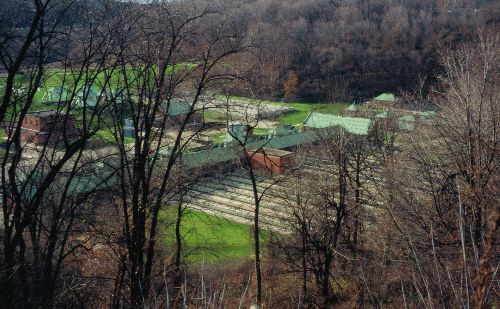In 1912, the Town of North Toronto was annexed to the City of Toronto. One of the main reasons the citizens of that town welcomed the change was the possibility of better water and sewage treatment.
Until the 1890s, the people of North Toronto obtained their water from wells on their own properties, but by 1890 a municipal system was required and a pumping station was built at the springs on Roselawn Avenue, west of Avenue Road. In 1902, the town acquired a site for a new waterworks in what is now Sherwood Park. The town had built some sanitary sewers in the part of the town then developed and three small disposal plants, none of which had the capacity to serve the ultimate requirements of the area.
In 1912, after annexation, the town’s watermains were linked up to the High Level Pumping Station on Poplar Plains Road, and the Sherwood Park pumping station was decommissioned. Improved sewage disposal could not be accomplished as easily. For one thing the existing deep Yellow Creek ravine made direct connection to the city system impractical. George Phelps, Engineer-in-charge of Sewers City of Toronto c1934, tells us “that a complete new system of sewers, with outlet to the Don River, and a new sewage treatment plant were necessary.” “As the construction of the sewers was delayed for about ten years on account of opposition from local ratepayers and because of the Great War, ample time was afforded to obtain fairly reliable information” for planning.
A decision had to be made whether to install separate or combined sewers. While George Phelps believed that “modern conditions will before long demand that separate sewers be used in practically all cases, as proper treatment of sewage from the smallest municipality is becoming general, and the dumping of crude sewage even into to the sea is not always good practice,” combined sewers were chosen largely because of the cost. This was rationalised by claiming that sewage would be dumped into the river is below the point where its water would be used for domestic or agricultural use. Also the river discharges into a land locked bay and so would not affect the city’s water supply, which comes from the deep water of the lake.

North Toronto Sewage Treatment Plant, from Millwood Road.
This site for the sewage treatment plant was chosen as it was close to the river so the effluent could be easily disposed of and the elevation was well below the level of the district to be served so that gravity flow was possible, so eliminating the necessity of pumping which can be very expensive. Where ever possible the trunk sewers were laid out along the existing valleys. In 1926, The City of Toronto authorising the construction of this sewage treatment plant at an estimated cost of $1 million. In addition to serving North Toronto, it was to serve the Town of Leaside and the Village of Forest Hill. It began operations on August 1, 1929. It may be closed in the next few years or used only to treat storm water.
North Toronto was one of the first plants in North America to use the biological activated sludge process. It is able to operate very efficiently at a controlled uniform rate of 34,000 cubic metres per day because wastewater exceeding plant capacity is diverted to the Ashbridges Bay Wastewater Treatment Plant. It has four primary, two secondary and four storage digesters on site.
Information from “A Complete Municipal Sewerage System” George Phelps, page 973, Engineering and Contract Record, November 14, 1934 and city websites.
